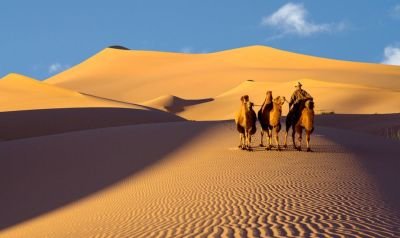
The Gobi is a large desert region in Asia. It covers parts of northern and northwestern China, and of southern Mongolia. The desert basins of the Gobi are bounded by the Altai Mountains and the grasslands and steppes of Mongolia on the north, by the Taklamakan Desert to the West, by the Hexi Corridor and Tibetan Plateau to the southwest, and by the North China Plain to the southeast. The Gobi is most notable in history as part of the Great Mongol Empire, and as the location of several important cities along the Silk Road.
The Gobi is made up of several distinct ecological and geographic regions based on variations in climate and topography.
One is the Eastern Gobi desert steppe ecoregion, a palearctic ecoregion in the deserts and xeric shrublands biome, home to the Bactrian camel and various other animals. It is a rain shadow desert formed by the Himalaya mountain range blocking rain-carrying clouds from the Indian Ocean from reaching the Gobi territory.
The Gobi measures over 1,600 km from southwest to northeast and 800 km from north to south. It is the fifth-largest desert in the world and Asia's largest.
Much of the Gobi is not sandy but has exposed bare rock.
Archeologists and paleontologists have done excavations in the Nemegt Basin in the northwestern part of the Gobi Desert, which is noted for its fossil treasures, including early mammals, dinosaur eggs, and prehistoric stone implements, some 100,000 years old.
The Gobi Desert is the source of many important fossil finds, including the first dinosaur eggs.
Despite the harsh conditions, these deserts and the surrounding regions sustain many animals, including black-tailed gazelles, marbled polecats, bactrian camels, Mongolian wild ass and sandplovers. They are occasionally visited by snow leopards, brown bears, and wolves. Drought-adapted shrubs in the desert included gray sparrow's saltwort, gray sagebrush, and low grasses such as needle grass and bridlegrass. Several large nature reserves have been established in the Gobi, including Gobi Gurvansaikhan National Park, Great Gobi A and Great Gobi B Strictly Protected Area.
The area is vulnerable to trampling by livestock and off-road vehicles (effects from human intervention are greater in the eastern Gobi Desert, where rainfall is heavier and may sustain livestock).
In Mongolia, grasslands have been degraded by goats, which are raised by nomadic herders as source of cashmere wool. The economic trends of livestock privatization and the collapse of the urban economy have caused people to return to subsistence rural lifestyles, away from urbanization.
Not indicating that the content you copy/paste is not your original work could be seen as plagiarism.
Some tips to share content and add value:
Repeated plagiarized posts are considered spam. Spam is discouraged by the community, and may result in action from the cheetah bot.
Creative Commons: If you are posting content under a Creative Commons license, please attribute and link according to the specific license. If you are posting content under CC0 or Public Domain please consider noting that at the end of your post.
If you are actually the original author, please do reply to let us know!
Thank You!
Hi! I am a robot. I just upvoted you! I found similar content that readers might be interested in:
https://en.wikipedia.org/wiki/Gobi_Desert
nice post. keep going. if u like read my post also